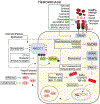Targeting TLR4-dependent inflammation in post-hemorrhagic brain injury
- PMID: 32249624
- PMCID: PMC8104018
- DOI: 10.1080/14728222.2020.1752182
Targeting TLR4-dependent inflammation in post-hemorrhagic brain injury
Abstract
Recent data have implicated inflammation of the cerebrospinal fluid spaces after subarachnoid, intraventricular, and intracerebral hemorrhage to be a critical driver of multiple secondary brain injuries such as hydrocephalus, cerebral edema, and vasospasm. While TLR4-dependent reparative inflammation is an important protective response that can eliminate physical irritants and damaged cells, sustained or inappropriately triggered inflammation can initiate or propagate disease.Areas covered: We review recent advances in our understanding of how TLR4, including its upstream damage-associated molecular patterns and its downstream MyD88-dependent and independent signaling pathways, contributes to hemorrhage-induced inflammation in numerous brain diseases. We discuss prospects for the pharmacotherapeutic targeting of TLR4 in these disorders, including the use of repurposed FDA-approved agents.Expert opinion: TLR4 inhibitors with good blood-brain-barrier (BBB) penetration could be useful adjuncts in post-hemorrhagic hydrocephalus and multiple other diseases associated with brain hemorrhage and inflammation.
Keywords: CSF hypersecretion; Intracerebral hemorrhage; choroid plexus epithelium; intraventricular hemorrhage; neuroinflammation; subarachnoid hemorrhage; toll-like receptor 4.
Conflict of interest statement
Declaration of interest
The authors have no relevant affiliations or financial involvement with any organization or entity with a financial interest in or financial conflict with the subject matter or materials discussed in the manuscript. This includes employment, consultancies, honoraria, stock ownership or options, expert testimony, grants or patents received or pending, or royalties.
Figures

Similar articles
-
Fluoxetine attenuates neuroinflammation in early brain injury after subarachnoid hemorrhage: a possible role for the regulation of TLR4/MyD88/NF-κB signaling pathway.J Neuroinflammation. 2018 Dec 20;15(1):347. doi: 10.1186/s12974-018-1388-x. J Neuroinflammation. 2018. PMID: 30572907 Free PMC article.
-
Inflammation-dependent cerebrospinal fluid hypersecretion by the choroid plexus epithelium in posthemorrhagic hydrocephalus.Nat Med. 2017 Aug;23(8):997-1003. doi: 10.1038/nm.4361. Epub 2017 Jul 10. Nat Med. 2017. PMID: 28692063
-
Recombinant ADAMTS 13 Attenuates Brain Injury After Intracerebral Hemorrhage.Stroke. 2015 Sep;46(9):2647-53. doi: 10.1161/STROKEAHA.115.009526. Epub 2015 Aug 6. Stroke. 2015. PMID: 26251246
-
Toll-Like Receptor 4 and Tenascin-C Signaling in Cerebral Vasospasm and Brain Injuries After Subarachnoid Hemorrhage.Acta Neurochir Suppl. 2020;127:91-96. doi: 10.1007/978-3-030-04615-6_15. Acta Neurochir Suppl. 2020. PMID: 31407069 Review.
-
Toll-like receptor 4 signaling in intracerebral hemorrhage-induced inflammation and injury.J Neuroinflammation. 2013 Feb 17;10:27. doi: 10.1186/1742-2094-10-27. J Neuroinflammation. 2013. PMID: 23414417 Free PMC article. Review.
Cited by
-
The choroid plexus links innate immunity to CSF dysregulation in hydrocephalus.Cell. 2023 Feb 16;186(4):764-785.e21. doi: 10.1016/j.cell.2023.01.017. Cell. 2023. PMID: 36803604 Free PMC article.
-
Strategies for Biomaterial-Based Spinal Cord Injury Repair via the TLR4-NF-κB Signaling Pathway.Front Bioeng Biotechnol. 2022 Apr 29;9:813169. doi: 10.3389/fbioe.2021.813169. eCollection 2021. Front Bioeng Biotechnol. 2022. PMID: 35600111 Free PMC article. Review.
-
Evaluation of the Choroid Plexus Epithelium Inflammation TLR4/NF-κB/NKCC1 Signal Pathway Activation in the Development of Hydrocephalus.CNS Neurosci Ther. 2024 Oct;30(10):e70085. doi: 10.1111/cns.70085. CNS Neurosci Ther. 2024. PMID: 39450988 Free PMC article.
-
Progress in Research on TLR4-Mediated Inflammatory Response Mechanisms in Brain Injury after Subarachnoid Hemorrhage.Cells. 2022 Nov 26;11(23):3781. doi: 10.3390/cells11233781. Cells. 2022. PMID: 36497041 Free PMC article. Review.
-
Neuroinflammatory pathways and potential therapeutic targets in neonatal post-hemorrhagic hydrocephalus.Pediatr Res. 2025 Mar;97(4):1345-1357. doi: 10.1038/s41390-024-03733-z. Epub 2024 Dec 26. Pediatr Res. 2025. PMID: 39725707 Review.
References
-
- Long B, Koyfman A, Runyon MS. Subarachnoid hemorrhage: updates in diagnosis and management. Emerg Med Clin North Am. 2017;35:803–824. - PubMed
-
- Broderick J, Connolly S, Feldmann E, et al. Guidelines for the management of spontaneous intracerebral hemorrhage in adults: 2007 update: a guideline from the American heart association/American stroke association stroke council, high blood pressure research council, and the quality of care and outcomes in research interdisciplinary working group. Stroke. 2007;38:2001–2023. - PubMed
-
- Elliott J, Smith M. The acute management of intracerebral hemorrhage: a clinical review. Anesth Analg. 2010;110:1419–1427. - PubMed
-
- Hemphill JC 3rd, Greenberg SM, Anderson CS, et al. Guidelines for the management of spontaneous intracerebral hemorrhage: a guideline for healthcare professionals from the American heart association/American stroke association. Stroke. 2015;46:2032–2060. - PubMed
Publication types
MeSH terms
Substances
Grants and funding
LinkOut - more resources
Full Text Sources
